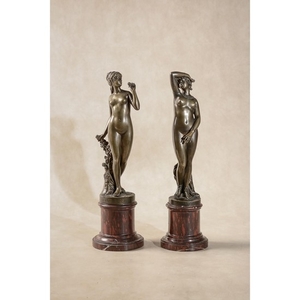A pair of German patinated bronze models of the Flower Queen and Phryne
A pair of German patinated bronze models of the Flower Queen and Phryne, circa 1875, by the Stotz Foundry, both portrayed standing and nude, the integrally cast circular bases inscribed in the maaquettes REINE DES FLEURS and PHRYNE respectively, both further inscribed P Stotz & Cie Stuttgart; on cylindrical marmo rouge griotte plinths
41cm high
CATALOGUE NOTES:
Paul Stotz (1850 - 1899) attended Stuttgart's polytechnic from 1866-67 and in 1869 joined the art school there, along with Karl Kopp, his uncle -who worked as a sculptor in the city. On completing his training Stotz worked in his father Albert's iron foundry as a draftsman and modeller, before moving to Vienna in 1873, where he worked as a journeyman in the Hollenbach bronze foundry
In 1876 Stotz moved back to the family business where he directed the newly formed department of Bronce-Waaren-Fabrik in the lower Neckarstraße 134. The production programme included furnishings, lighting fixtures, busts, statuettes, grave monuments and other fittings. In 1882, the department's ownership was transferred fully to Paul Stotz, and he wasted no time in building a new factory at Neckarstraße 142, opening as Paul Stotz & Co
View it on
Sale price
Estimate
Time, Location
Auction House
A pair of German patinated bronze models of the Flower Queen and Phryne, circa 1875, by the Stotz Foundry, both portrayed standing and nude, the integrally cast circular bases inscribed in the maaquettes REINE DES FLEURS and PHRYNE respectively, both further inscribed P Stotz & Cie Stuttgart; on cylindrical marmo rouge griotte plinths
41cm high
CATALOGUE NOTES:
Paul Stotz (1850 - 1899) attended Stuttgart's polytechnic from 1866-67 and in 1869 joined the art school there, along with Karl Kopp, his uncle -who worked as a sculptor in the city. On completing his training Stotz worked in his father Albert's iron foundry as a draftsman and modeller, before moving to Vienna in 1873, where he worked as a journeyman in the Hollenbach bronze foundry
In 1876 Stotz moved back to the family business where he directed the newly formed department of Bronce-Waaren-Fabrik in the lower Neckarstraße 134. The production programme included furnishings, lighting fixtures, busts, statuettes, grave monuments and other fittings. In 1882, the department's ownership was transferred fully to Paul Stotz, and he wasted no time in building a new factory at Neckarstraße 142, opening as Paul Stotz & Co



